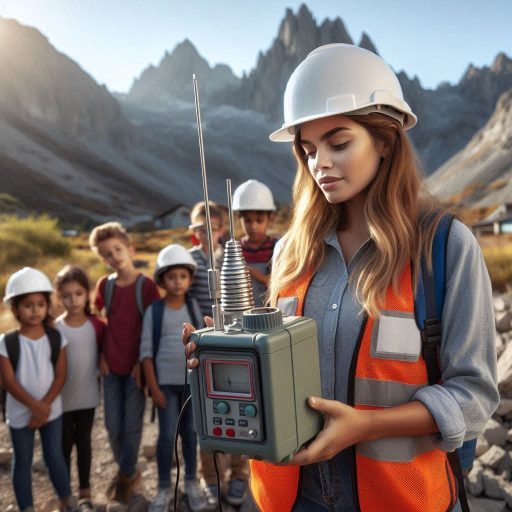Introduction
Seismology equipment plays a crucial role in understanding Earth’s seismic activities, providing invaluable insights into the dynamics of our planet.
Instruments such as seismometers, accelerometers, and GPS sensors are designed to detect and measure vibrations caused by earthquakes, volcanic activity, and other geological events.
Seismometers, for example, are highly sensitive devices that record ground motion, allowing scientists to analyze the magnitude, frequency, and duration of seismic waves.
Accelerometers measure acceleration during seismic events, offering a clearer picture of how ground movement affects structures.
Additionally, GPS sensors help monitor tectonic plate movements over time, contributing to our understanding of long-term geological processes.
However, the effectiveness of this equipment heavily relies on proper maintenance and calibration.
Regular maintenance ensures that instruments operate at peak efficiency, minimizing the risk of malfunctions or inaccuracies that can compromise research findings.
Just like any complex machinery, seismology equipment can suffer from wear and tear, exposure to environmental conditions, and technological obsolescence.
Therefore, conducting routine inspections, cleaning, and timely repairs is essential to extend the lifespan of these instruments and ensure they perform reliably.
Types of Seismology Equipment
Seismology relies on various types of equipment to monitor and analyze seismic activity.
Each instrument plays a crucial role in data collection and interpretation.
Here, we will explore some essential types of seismology equipment.
Seismometers
Seismometers are the primary instruments used to detect ground motion.
They measure seismic waves generated by earthquakes and other geological events.
Seismometers consist of a mass suspended on a spring.
As the ground shakes, the mass remains still, allowing the instrument to record motion.
This data helps scientists understand the intensity and duration of seismic events.
Accelerometers
Accelerometers measure the acceleration of ground motion during seismic events.
Unlike seismometers, which measure displacement, accelerometers provide real-time data on how quickly the ground is moving.
This information is vital for earthquake engineering and building design.
Engineers use accelerometer data to assess how structures will respond to seismic forces.
Data Loggers
Data loggers play a significant role in seismology.
These devices collect and store data from various seismology instruments.
Data loggers can process large amounts of information efficiently.
They often include software that allows researchers to analyze data over time.
This analysis helps identify patterns and trends in seismic activity.
GPS Receivers
GPS receivers are increasingly important in seismology.
They provide precise location data for seismic stations and help monitor ground deformation.
GPS technology enables scientists to track subtle changes in the Earth’s crust.
This information is crucial for understanding tectonic movements and potential earthquake risks.
Other Auxiliary Equipment
In addition to the main instruments, there are other auxiliary equipment used in seismology.
These include devices like strong motion recorders and portable seismic stations.
Strong motion recorders capture intense shaking during significant earthquakes.
They provide valuable data for assessing structural integrity and disaster response.
Portable seismic stations allow for flexible data collection in various environments.
Researchers can deploy these stations quickly in response to seismic events.
They help capture real-time data in remote or affected areas, contributing to immediate response efforts.
Overall, the variety of seismology equipment plays a critical role in monitoring the Earth’s movements.
Each type of instrument contributes unique data and insights into seismic events.
Regular maintenance and calibration of this equipment ensure accurate data collection.
This process is vital for advancing our understanding of earthquakes and improving safety measures.
Seismometers, accelerometers, data loggers, GPS receivers, and auxiliary equipment all work together in seismology.
Their combined efforts enhance our ability to study and respond to seismic activity effectively.
Investing in high-quality equipment and maintaining it properly is essential for any seismological research program.
Read: U.S. Cities with the Most Opportunities for Environmental Scientists
Importance of Regular Maintenance
Regular maintenance of seismology equipment is crucial for accurate data collection and analysis.
This practice ensures that each instrument functions properly and provides reliable information.
Below are some key reasons why regular maintenance is essential for seismological tools.
Ensures Equipment is Functioning Properly
Regular maintenance helps confirm that all equipment operates at peak performance.
Over time, wear and tear can affect sensors and components.
By routinely checking and calibrating instruments, technicians can identify and rectify issues before they lead to significant malfunctions.
This proactive approach ensures that seismometers, accelerometers, and other devices provide accurate readings during seismic events.
Extends the Lifespan of the Equipment
Maintenance plays a vital role in prolonging the life of seismology equipment.
Regularly servicing instruments reduces wear and helps maintain their integrity.
This can include cleaning components, replacing worn parts, and updating software.
By investing time and resources into maintenance, researchers can maximize the lifespan of their equipment, ensuring long-term usability.
Reduces the Risk of Errors in Data Collection
Errors in data collection can have severe consequences in seismology.
Inaccurate data can lead to misinterpretations of seismic activity, affecting public safety and disaster response strategies.
Regular maintenance minimizes the risk of errors by ensuring that equipment is calibrated and functioning correctly.
Technicians can address issues that may compromise data quality, allowing researchers to make informed decisions based on reliable information.
Improves Data Quality and Reliability
Regular maintenance enhances the overall quality of data collected by seismology equipment.
Well-maintained instruments produce more consistent and accurate measurements.
This reliability is crucial for building databases that researchers rely on for analysis.
Improved data quality also strengthens the validity of scientific studies, fostering greater trust in the findings.
Facilitates Compliance with Standards
Many seismology equipment manufacturers and regulatory bodies have specific maintenance standards.
Adhering to these standards is essential for maintaining equipment warranties and certifications.
Regular maintenance ensures compliance with industry regulations, which can be critical for funding and support.
It also demonstrates a commitment to best practices in scientific research.
Regular maintenance of seismology equipment is essential for ensuring proper function, extending lifespan, and reducing data collection errors.
By prioritizing maintenance, researchers can improve data quality and ensure compliance with industry standards.
Ultimately, these efforts enhance the reliability of seismic research and contribute to a deeper understanding of our planet’s dynamics.
Investing in regular maintenance is a vital step in supporting effective seismological studies.
Read: Environmental Scientist vs. Ecologist: Roles and Differences in the US
Calibration Procedures for Seismometers
Calibrating seismometers is essential for ensuring accurate measurements of seismic activity.
Calibration procedures involve several critical steps that help maintain the precision and reliability of these instruments.
Below are the key calibration procedures for seismometers.
Checking and Adjusting Sensitivity
The first step in calibrating a seismometer is to check its sensitivity.
Sensitivity refers to the instrument’s ability to detect small ground movements.
Technicians use reference signals to test the seismometer‘s response.
If the sensitivity is not within specified parameters, adjustments are made.
Proper sensitivity ensures that the instrument can detect seismic waves effectively, providing reliable data during seismic events.
Testing Frequency Response
The next calibration step involves testing the frequency response of the seismometer.
Each seismometer is designed to respond to specific frequency ranges.
Technicians generate signals at various frequencies to assess how well the instrument responds.
This process helps identify any deviations from expected performance.
By ensuring accurate frequency response, technicians can confirm that the seismometer captures all relevant seismic data, including low and high-frequency waves.
Verifying Proper Functioning of Damping Systems
Damping systems in seismometers play a crucial role in stabilizing measurements.
These systems prevent oscillations that could distort data.
During calibration, technicians verify that the damping systems function correctly.
They assess how well the system controls the movement of the sensor during ground shaking.
Properly functioning damping systems are vital for achieving accurate readings and reducing noise in the data collected.
Ensuring Correct Installation and Orientation
The installation and orientation of seismometers are critical for accurate measurements.
During calibration, technicians check that the instrument is installed correctly and aligned with the local geographic orientation.
This includes ensuring that the seismometer is level and properly anchored.
Misalignment can lead to inaccurate readings and compromise the data’s validity.
Technicians also verify that the instrument is securely positioned to withstand environmental factors like wind and vibrations.
Transform Your Career Today
Unlock a personalized career strategy that drives real results. Get tailored advice and a roadmap designed just for you.
Start NowDocumentation and Record Keeping
Proper documentation of calibration procedures is essential.
Technicians should record all adjustments, tests, and results during the calibration process.
This documentation serves as a reference for future maintenance and ensures compliance with industry standards.
Keeping detailed records also allows researchers to track the performance of the instrument over time, identifying any recurring issues that may require attention.
In summary, calibration procedures for seismometers include checking and adjusting sensitivity, testing frequency response, verifying damping systems, and ensuring proper installation.
These steps are crucial for maintaining the accuracy and reliability of seismological data.
By adhering to strict calibration protocols, researchers can enhance the quality of their seismic measurements and contribute to a better understanding of seismic activity.
Regular calibration ensures that seismometers provide dependable data, ultimately improving safety and preparedness in earthquake-prone areas.
Read: The Relationship Between U.S. Policy & Environmental Scientist Roles

Calibration Procedures for Accelerometers
Calibrating accelerometers is crucial for obtaining accurate measurements of ground motion during seismic events.
Proper calibration ensures that these instruments can effectively capture the acceleration of seismic waves.
Below are the key calibration procedures for accelerometers.
Checking Linearity
The first step in calibrating an accelerometer is checking its linearity.
Linearity refers to how accurately the accelerometer responds to a range of acceleration values.
Technicians apply known acceleration inputs and measure the corresponding outputs from the device.
A linear relationship indicates that the accelerometer functions correctly across its measurement range.
If deviations are observed, adjustments are made to ensure linearity, which is vital for accurate data interpretation.
Verifying Sensitivity
Next, technicians verify the sensitivity of the accelerometer.
Sensitivity measures how effectively the device converts acceleration into an electrical signal.
To test this, known acceleration values are applied to the accelerometer, and the output signals are recorded.
If the output does not match the expected values, adjustments are made to align sensitivity with manufacturer specifications.
Proper sensitivity is crucial for detecting even small accelerations during seismic events.
Calibrating Dynamic Range
The dynamic range of an accelerometer defines the span of acceleration values it can accurately measure.
Calibrating dynamic range involves testing the accelerometer across its full operational limits.
Technicians apply various levels of acceleration, both low and high, to ensure the device responds correctly.
This process helps confirm that the accelerometer can handle extreme seismic conditions without saturating or losing accuracy.
A well-calibrated dynamic range ensures that all relevant seismic data is captured.
Ensuring Proper Attachment and Orientation
Proper attachment and orientation of the accelerometer are vital for accurate measurements.
During calibration, technicians check that the accelerometer is securely mounted to the structure or surface being monitored.
They ensure that the device is oriented correctly, typically aligned with the expected direction of motion.
Misalignment can lead to inaccurate readings, so careful attention is paid to this step.
Additionally, technicians verify that the accelerometer is securely attached to minimize any external influences on its readings.
Documenting Calibration Procedures
Thorough documentation of calibration procedures is essential for quality control.
Technicians should record all calibration tests, adjustments, and results.
This documentation serves as a reference for future calibrations and helps maintain compliance with industry standards.
Keeping detailed records also allows researchers to monitor the accelerometer’s performance over time, identifying any trends or recurring issues that may require further investigation.
Calibration procedures for accelerometers include checking linearity, verifying sensitivity, calibrating dynamic range, and ensuring proper attachment and orientation.
These steps are critical for maintaining the accuracy and reliability of seismic measurements.
By following stringent calibration protocols, researchers can enhance the quality of their data collection and contribute to a better understanding of ground motion during seismic events.
Regular calibration of accelerometers ensures they provide dependable data, ultimately improving safety and preparedness in earthquake-prone regions.
Read: Organizations & Associations for Environmental Scientists in the USA
Calibration Procedures for Data Loggers
Data loggers are essential tools in seismology, collecting and storing data from various seismic instruments.
Proper calibration of data loggers is crucial to ensure they function effectively and provide accurate data.
Below are the key calibration procedures for data loggers.
Verifying Accuracy of Timekeeping
The first step in calibrating a data logger is verifying the accuracy of its timekeeping.
Accurate timekeeping is essential for synchronizing data collected from different instruments.
Technicians compare the data logger‘s clock with a precise time source, such as a GPS signal.
Any discrepancies in time are adjusted to ensure that all data is time-stamped accurately.
Reliable timekeeping allows researchers to correlate data from multiple sources effectively.
Calibrating Analog-to-Digital Converters
Data loggers often include analog-to-digital converters (ADCs) to process incoming signals.
Calibrating these converters ensures that they accurately translate analog signals into digital data.
Technicians apply known input voltages and measure the output from the ADC.
They compare the measured output with the expected values to verify accuracy.
If discrepancies are found, adjustments are made to align the ADC‘s performance with specifications.
Proper calibration of ADCs is critical for accurate data representation.
Checking Battery Life and Power Supply
Another important calibration procedure involves checking the battery life and power supply of the data logger.
Data loggers often operate in remote locations where power sources may be limited.
Technicians test the battery under various operating conditions to ensure it can sustain long-term data collection.
They also verify that the power supply is stable and sufficient for the device‘s requirements.
Ensuring reliable power sources helps prevent data loss during critical monitoring periods.
Testing Communication Interfaces
Data loggers typically communicate with other devices to transmit data.
Testing the communication interfaces is a vital calibration step.
Technicians check the functionality of various interfaces, such as USB, Ethernet, or wireless connections.
They verify that data can be sent and received without errors.
Any issues identified during testing are addressed to ensure seamless communication between the data logger and other instruments.
Properly functioning communication interfaces are crucial for real-time data access and monitoring.
Documenting Calibration Procedures
Thorough documentation of calibration procedures is essential for maintaining data logger quality.
Technicians should record all calibration tests, adjustments, and results.
This documentation serves as a reference for future calibrations and ensures compliance with industry standards.
Keeping detailed records allows researchers to monitor the performance of data loggers over time, identifying trends or recurring issues that may require attention.
Calibration procedures for data loggers include verifying the accuracy of timekeeping, calibrating analog-to-digital converters, checking battery life and power supply, and testing communication interfaces.
These steps are critical for ensuring that data loggers function accurately and reliably.
By adhering to strict calibration protocols, researchers can enhance the quality of their seismic data collection and contribute to a deeper understanding of seismic activity.
Regular calibration of data loggers ensures they provide dependable data, ultimately improving safety and preparedness in earthquake-prone areas.
You Might Also Like: Becoming a Forensic Scientist: Steps and Education
Best Practices for Maintaining Seismology Equipment
Maintaining seismology equipment is vital for ensuring accurate data collection and analysis.
Implementing best practices for maintenance can extend the lifespan of instruments and improve the quality of seismic data.
Here are some key best practices for maintaining seismology equipment.
Regular Cleaning and Inspection
Regular cleaning and inspection of seismology equipment are essential to maintain optimal performance.
Dust, debris, and moisture can negatively impact the accuracy of sensors.
Technicians should establish a routine cleaning schedule for all instruments.
This includes wiping down surfaces, checking for corrosion, and inspecting cables and connections.
By conducting regular inspections, potential issues can be identified early, preventing costly repairs and ensuring accurate readings.
Following Manufacturer’s Guidelines
Adhering to the manufacturer’s guidelines for maintenance and calibration is crucial.
Each piece of seismology equipment comes with specific recommendations for care and handling.
Technicians should familiarize themselves with these guidelines to ensure proper maintenance procedures.
This includes information on calibration intervals, cleaning protocols, and recommended operating conditions.
Following manufacturer guidelines helps maintain the integrity of the equipment and ensures compliance with industry standards.
Showcase Your Business Today
Reach thousands of readers actively exploring professional services. Publish your business profile and grow your audience now.
Publish NowKeeping Detailed Records of Maintenance and Calibration
Maintaining detailed records of all maintenance and calibration activities is a best practice that cannot be overlooked.
These records provide a comprehensive history of the equipment’s performance and maintenance.
Technicians should document all inspections, cleaning, repairs, and calibrations, noting dates and findings.
This documentation can help identify trends in equipment performance and guide future maintenance decisions.
Additionally, having detailed records aids compliance with regulatory requirements and supports accountability within the organization.
Training Staff on Proper Handling and Care
Training staff on the proper handling and care of seismology equipment is essential for maintaining its integrity.
Staff members should receive training on the specific requirements for each piece of equipment.
This includes guidance on installation, calibration, and routine maintenance.
Training should also cover best practices for avoiding damage during transport and setup.
By empowering staff with knowledge, organizations can ensure that equipment is handled correctly, reducing the risk of errors or damage.
Implementing a Maintenance Schedule
Establishing a regular maintenance schedule is another best practice that promotes consistent care.
Organizations should outline a timeline for cleaning, inspection, and calibration activities.
This proactive approach helps ensure that all equipment is maintained systematically, reducing the likelihood of equipment failure.
A well-structured maintenance schedule keeps all team members accountable and ensures that no instrument is overlooked.
Utilizing Specialized Tools and Equipment
Using specialized tools for maintenance tasks can also enhance the effectiveness of maintenance practices.
For example, specific cleaning solutions may be recommended for sensitive sensors.
Using the right tools ensures that maintenance is conducted safely and effectively, minimizing the risk of damage.
In fact, best practices for maintaining seismology equipment include regular cleaning and inspection, following manufacturer guidelines, keeping detailed records, and training staff on proper handling.
Implementing these practices enhances the reliability and accuracy of seismic measurements.
By prioritizing maintenance, organizations can extend the lifespan of their equipment and improve data quality, ultimately contributing to a better understanding of seismic activity.
Regular upkeep ensures that seismology instruments function optimally, providing crucial data for research and disaster preparedness.
You Might Also Like: Networking Tips for Aspiring Geologists
Discover More: How to Publish Research in Climatology Journals
Learn More: Innovations and Trends in Zoology Research Techniques
Conclusion
Maintaining and calibrating seismology equipment is crucial for ensuring accurate measurements in seismic research.
Regular maintenance helps keep instruments functioning optimally over time, preventing costly breakdowns and ensuring longevity.
Proper calibration verifies that equipment provides reliable data, which is essential for both research and monitoring efforts.
Accurate seismology equipment plays a vital role in detecting and analyzing seismic activity, particularly during earthquakes and other significant geological events.
Researchers depend on precise data to analyze seismic activity effectively.
This data informs safety measures and emergency response strategies, allowing communities to prepare for potential hazards.
Moreover, well-maintained instruments contribute to long-term studies on earthquake patterns, improving our understanding of tectonic movements.
Consistent calibration helps avoid costly errors and misinterpretations that could lead to disastrous outcomes.
Investing in equipment upkeep strengthens the overall reliability of seismological research and enhances the accuracy of seismic data collection.
Accurate seismology equipment supports scientists in understanding Earth’s movements more effectively.
This understanding is vital for protecting communities and advancing geological knowledge.
[E-Books for Sale]
The Big Book of 500 High-Paying Jobs in America: Unlock Your Earning Potential
$19.99 • 500 High-Paying Jobs • 330 pages
Explore 500 high-paying jobs in America and learn how to boost your career, earn more, and achieve success!
See All 500 High-Paying Jobs of this E-Book
1001 Professions Without a Degree: High-Paying American Jobs You Can Start Now
$19.99 • 1001 Professions Without a Degree • 174 pages
Discover 1001 high-paying jobs without a degree! Unlock career tips, skills, and success strategies for just $19.99!




